Himalaya – ‘The Abode of Ice’, a range of fold mountains formed by the collision between the Indian tectonic plate with the Eurasian tectonic plate. The huge folds went way high into the sky and are more than enough to intimidate you and crush your ego nonchalantly. You just cannot simply visit the Himalayas and return home. You come here, you realise how puny are the things which we care about, realise how puny are our thoughts, realise how difficult it is for the natives to live up to the challenges of living here, realise the magnanimity, the grandeur, the beauty and the might of Mother Nature. Let me try to take you through one such, revelation filled journey through the mountains.
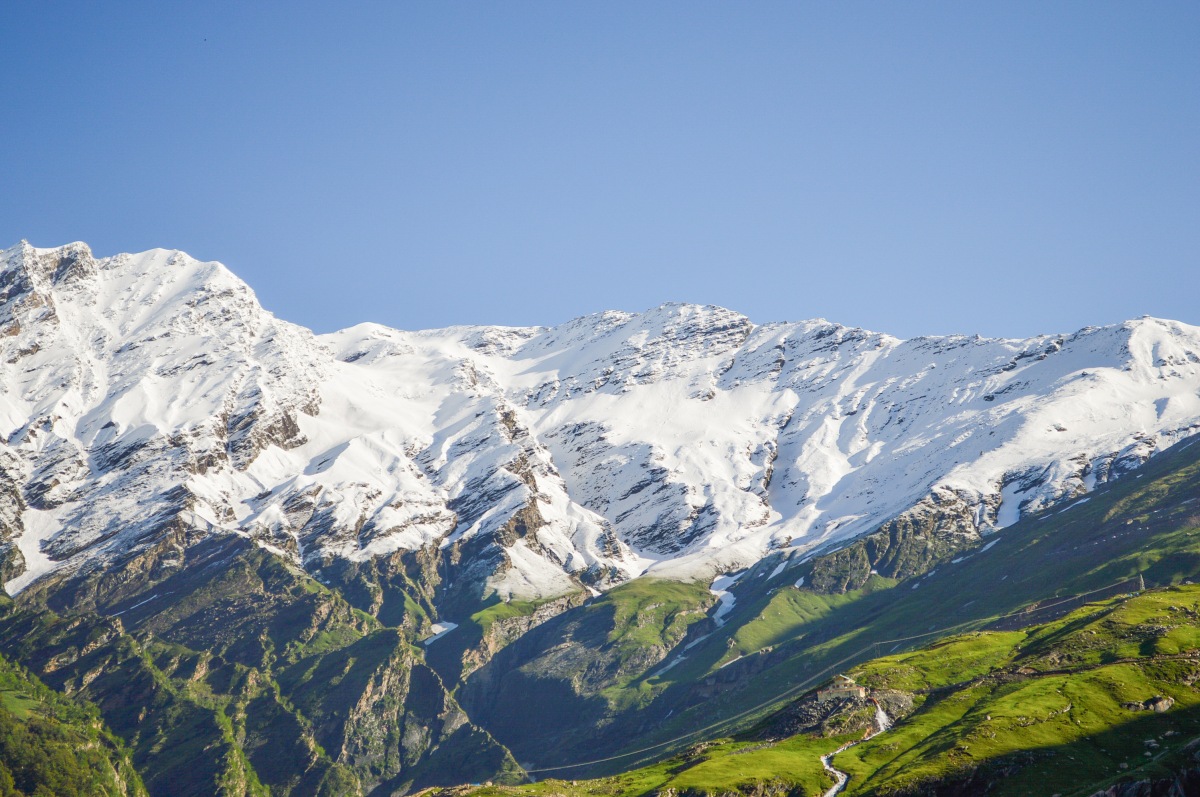
‘La’ stands for a pass. Rohtang La is the first pass one would encounter while travelling
from Manali to Leh. It gives you enough of a glimpse of what surprises might lay ahead. The road is embellished by such three colored views while the sun rays play peekaboo through the mountains and give an even more dramatic finishing to the landscape. At times, up at the pass, visibility reduces to around 80 meters owing to the dense fog. Its like heading nowhere! Rohtang La is the gateway to Lahaul and Spiti Valley, the stark and yet fascinating face of the Himalayas. Hereon, the greens recede and the white snow and brown soil underneath paint elegant landscapes of their own.

One of the biggest and high altitude located lakes in India. We were lucky to be able to see this lake just one day after it had snowed, for such a sight is uncommon during the summers. The waters in this part of the country reflect precisely the shade of the skies above clearly because they are untouched by humans. Here, we have the cold glazed glass look. The mountains surrounding it looked like they were garnished with freshly sifted snow. The vehicles traveling along the narrow path bordering the lake seemed to resemble the crawling baby roaming around the house while being supervised by the magnificent lake and the mountains, like a mother. Winters provide a more fascinating view as the water surface turns into solid ice, and people arrange for treks over the ice covered lake and even rivers – called chaadar trek, dangerous but worth the thrill!
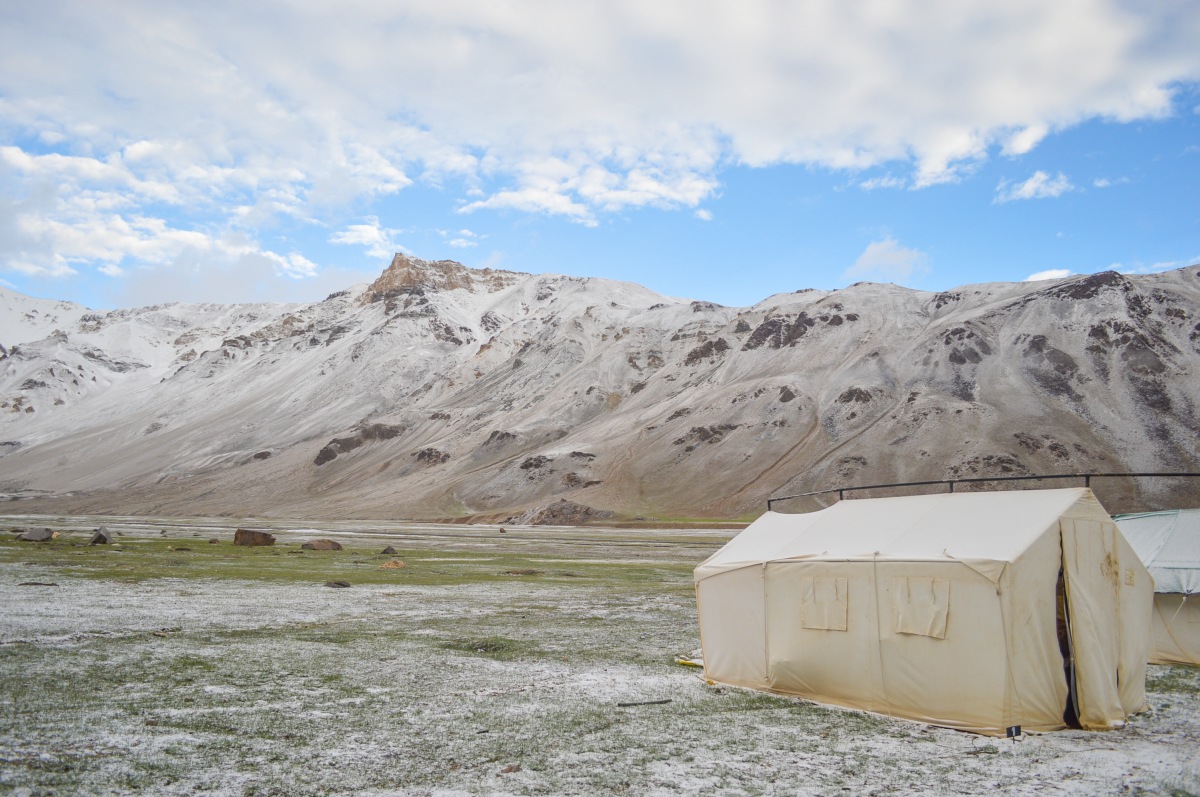
The inevitable strategic stop travelers must take while traveling from Manali to Leh. The valley consists of a single road which extends both ways so long that you can see them converge to a single point. It is as if the mountains gulp down the road. The road has huge plains on one side and the Tsarap river valley some distance on the other side. Various adventure camp organisers have put up their tents on the plains along the foot of the mountains wherein travelers can rest for a night. There isn’t much else to tell about this place, just that it doesn’t usually look like this during summers. We had been sleeping in the tent through a snowfall at night! It was the longest and the most difficult night I ever went through. I could count each and every second as it passed. It became difficult to sleep as time dragged slowly. With such high altitudes come low oxygen levels, which meant one could not breathe enough, let alone sleep peacefully. Added to it, the night time coolness was so harsh, it became extremely unpleasant to even shift in bed as any new part of the bed the body landed on, felt colder than ice, even through the multiple layers of sweaters, body warmers and jackets. It was as if, whatever movement had to be done, had to be done within the domains of earlier occupied space on the bed under the thick dull blankets. I even found myself praying to God to give me strength to survive till morning. And then the welcome morning woke us up to the pleasant view of snow sprinkled all over the place. The tent managers served us with hot tea and I realised the amount of endurance, will power and guts these managers might be having to survive each and every night at this place… I actually felt the tea running down through to my stomach as it unfroze my inner muscles. Negative temperature, hostile weather, trying to stay put, closest I have been to death, one gem of an experience!
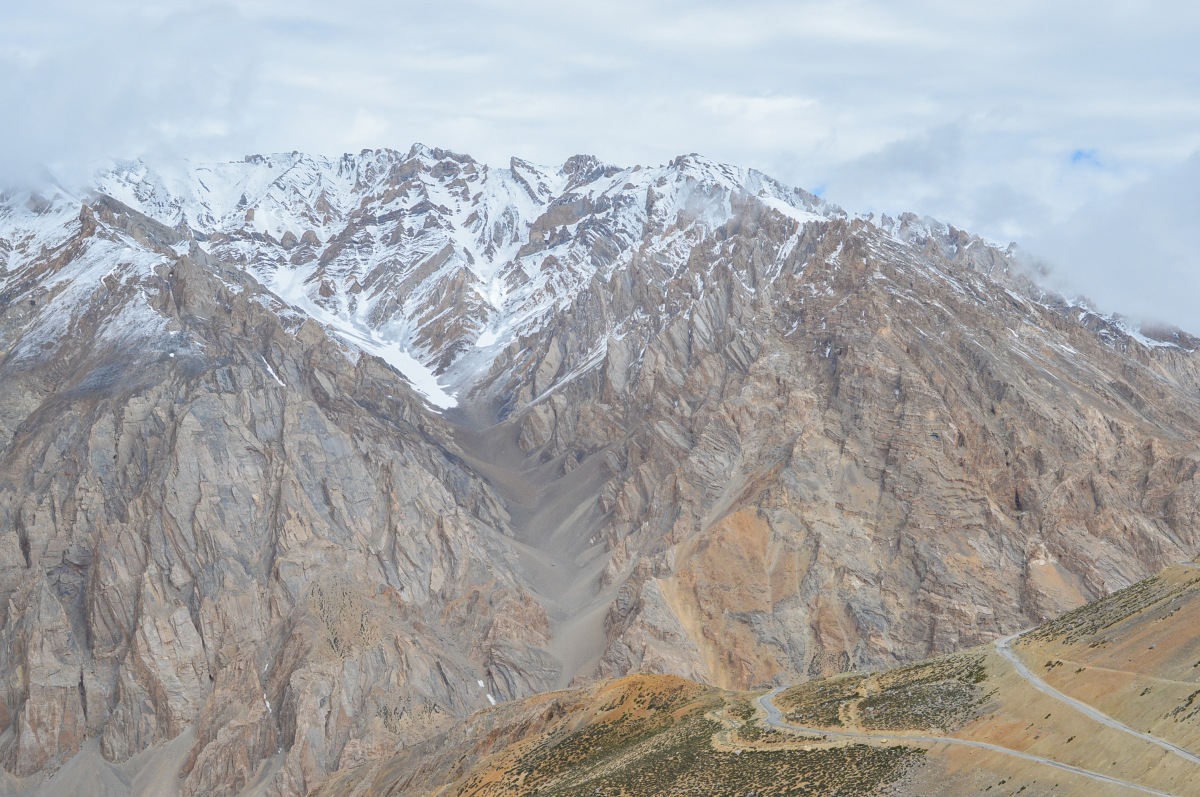
Just to set the proportions right, that is how small the 2 lane roads look in comparison with the Himalayas. There are times when while traveling through the valley, one has to crane his/her neck vertically up to see the tip of the mountain, and if your jaw is not already dropped in amazement, the craning of neck will ensure you do it! Sometimes even those peaks are obscured by the clouds. The roads go zig-zagging up the mountains, a tough challenge for the drivers, as they are tested to their core especially when you have another vehicle incoming at 12 o’clock. The rocks on the mountains take stunning forms with the loose soil frozen while flowing around them. One might also marvel at the existence of so many different shades of brown and the pleasant landscapes they create together.
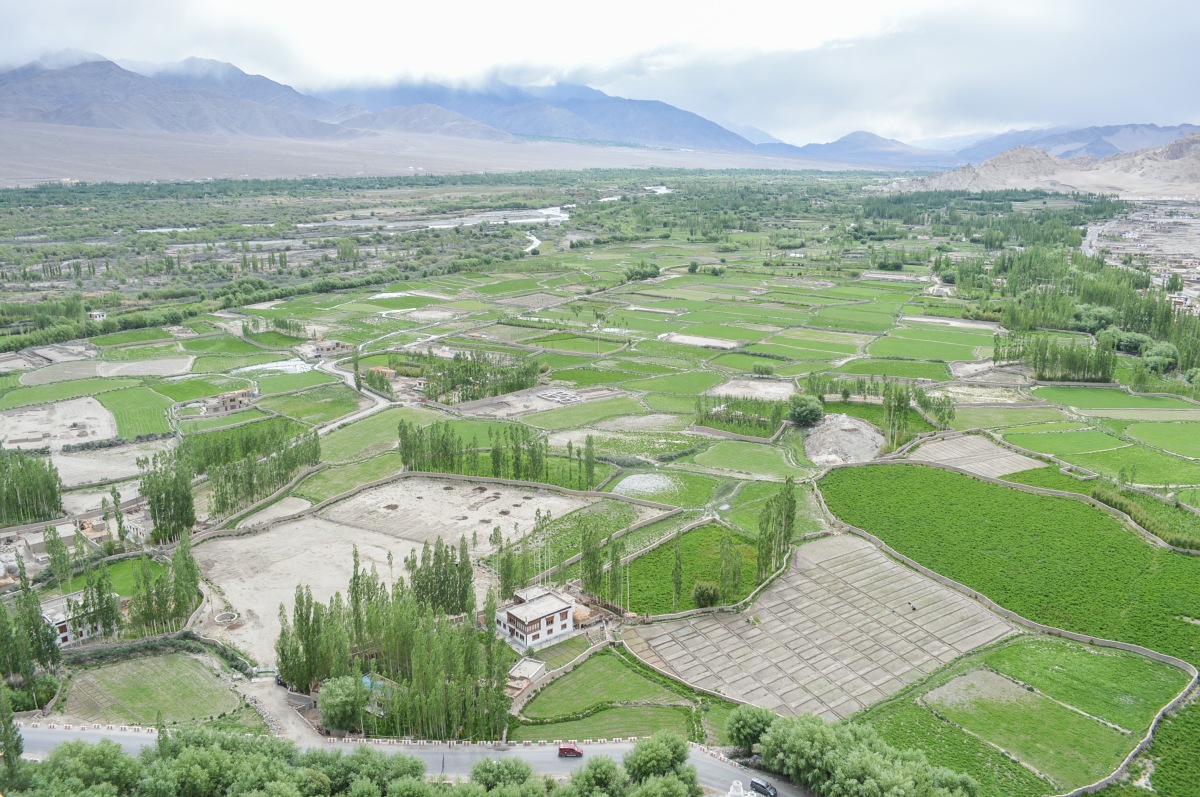
The first significant traces of greens after Lahaul Spiti are encountered on entering the
Ladakh Range. Karu, Shey, Choglamsar are some of the towns that greet us while Leh City awaits us. Just like Egypt is said to be gifted with Nile, it won’t be wrong to say Sindhu River has gifted the Leh Valley. Visible in the photograph as a meandering glimmering line among the greens, the Sindhu River has some of the cleanest water that can be ever seen in a river. They have festivals celebrated along the banks of the river, which are mostly a form of worship to the river itself, and they don’t bathe in the river to wash away their sins and shit, which makes the worship a true one, unlike River Ganga. The photograph taken from the Thiksey Monastery also shows the beautiful farming patterns the natives have designed here, it resembles a bi-colored attractive quilt made from rags! The farms are separated by distinct mud barriers, around waist high, which kind of gives a bold outline of each farm and then there are the tall and erect drokchang trees (Ladakhi willow) scattered between the farms playing scarecrows! Looks organised and beautiful.

Turning 180 degrees from the position in which the previous photograph was clicked, one could see this view. There occurred a cloudburst in Leh Valley back in 2010, the left part of the photograph represents the damage caused by the nature’s fury for there used to be houses there similar to the ones visible in the right part of the photograph. They are taking efforts to restore it to its original condition. After 48 exhilarating hours of pure admiration of nature, Leh City was our first exposure to a decently developed civilization and thus to the outside world through news. This was where we learned about the then ongoing cloudburst and the resulting floods in Uttarakhand state (15 June 2013) – some 400 km from the Leh Valley. This was when I was able to relate the cold dull look of the skies for the past two days and the overnight snowfall at Sarchu. A shiver ran down my spine…
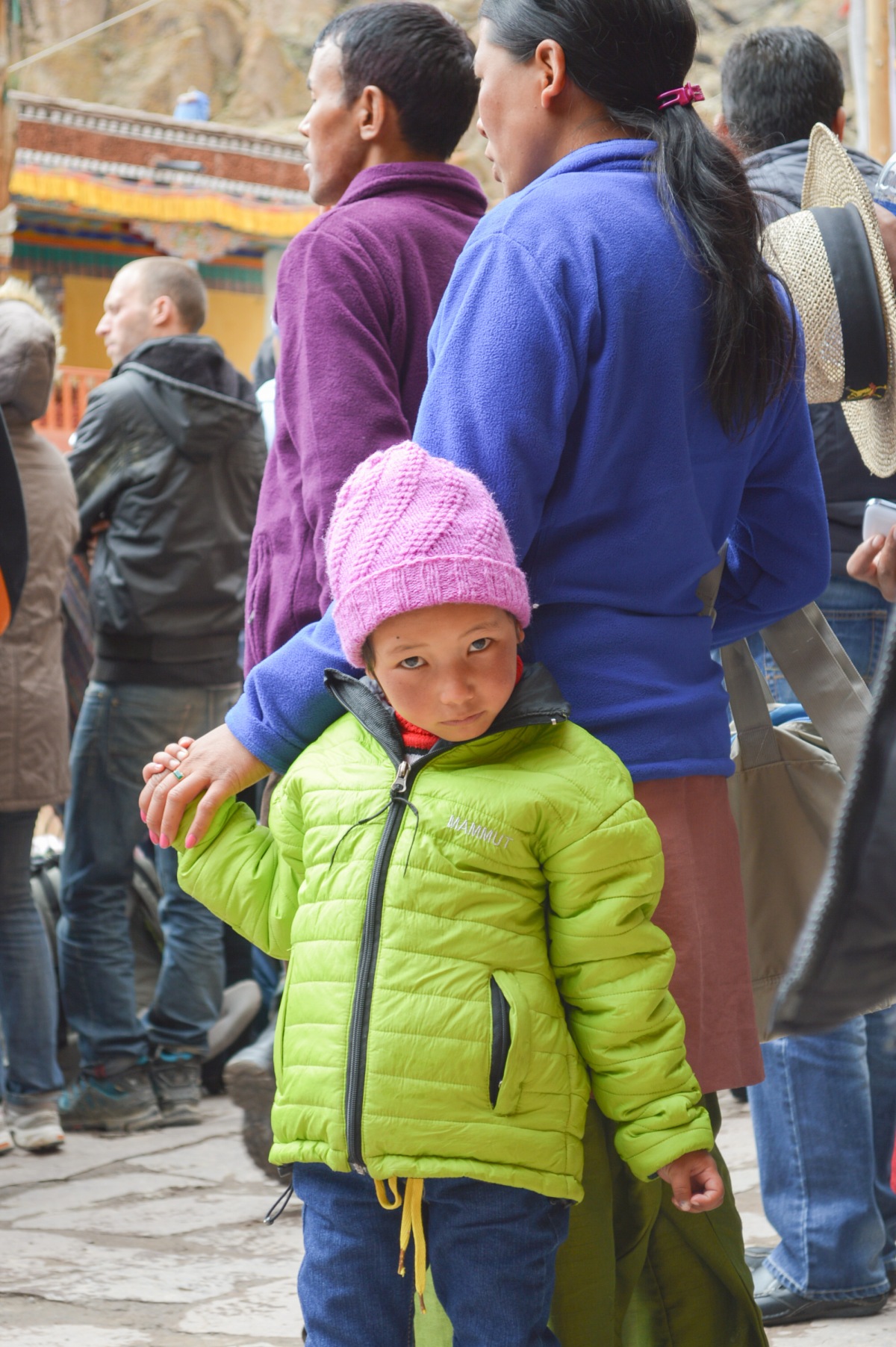
It may be the cold climate of the place or it may simply be congenital, the rosy cheeks are a common feature of the natives here. It kind of enhances the calm and composed attitude of the people. Majority of them being Buddhist, Leh locals certainly seem to have a highly developed sense of brotherhood, hard work, and most importantly, their sweet demeanour. You should see them talk in their local Ladakhi language, it sounds very much like a poem.
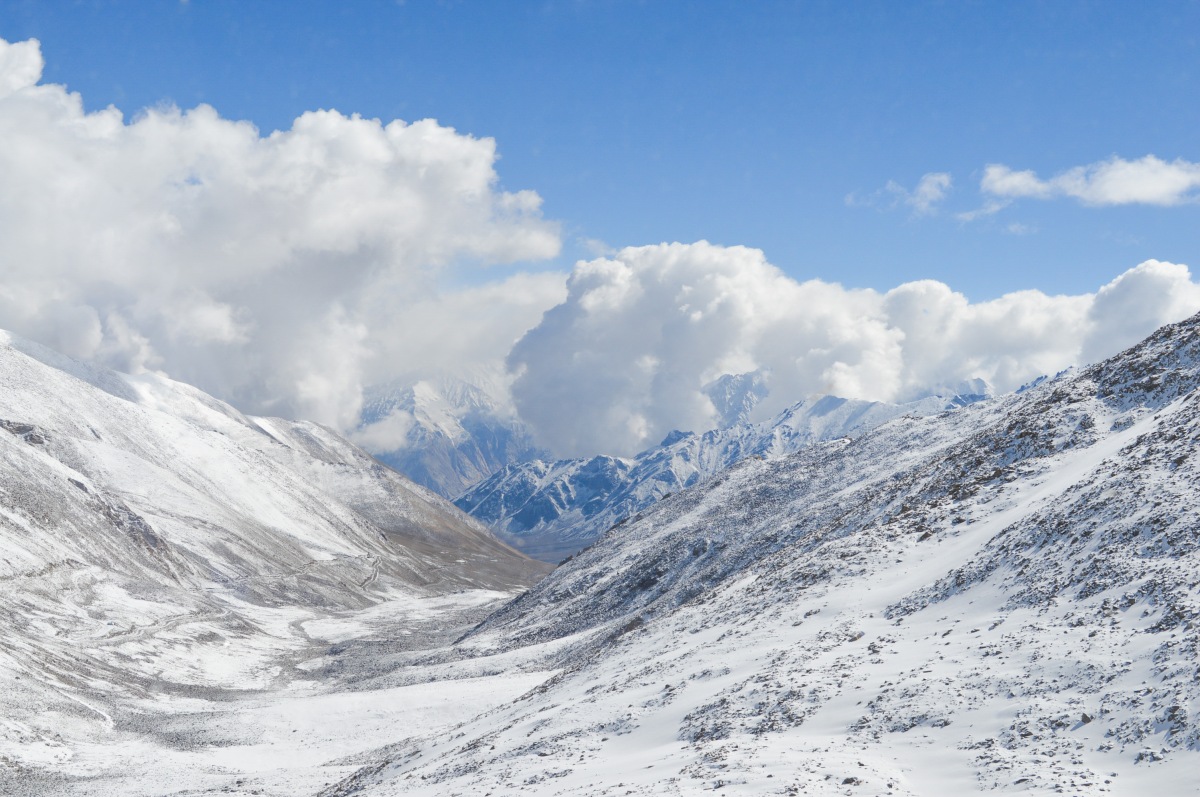
Though not exactly the pass, the photograph shows what it looks like standing at one of the highest motorable roads in the world. Once again to set the perspective right, try to see the fine line waving along the ranges on the left – that is the two lane road. The Leh valley or the Sindhu river valley stretches on one side of the pass, and the Shyok river valley (in the photograph) on the other. Once again, we were lucky enough to see this place dressed in whites like this during summers. The clouds here keep descending on the roads. An interesting event that usually happens in such ice-clad regions, which also happened here is the wrapping of vehicle tyres with metallic chains to get a good grip on the ice coated raods. Vehicles skid on the ice and brakes, if not applied properly make it even worse. “Daro mat, nahi girega” said our driver bhaiya – Tsewang Rinchen, in his sweet Ladakhi accent, as he very meticulously brought the Innova to a halt. There was little margin for error on that road. The tyre wrapping process was fun to watch. At 18,380 ft – 5.6 km (the value is debatable, but that is not the point!) above sea level, this place leaves you breathless, aesthetically more than literally. It really amazes me, the way the Indian Army and the Border Roads Organisation takes guard on such hostile grounds!
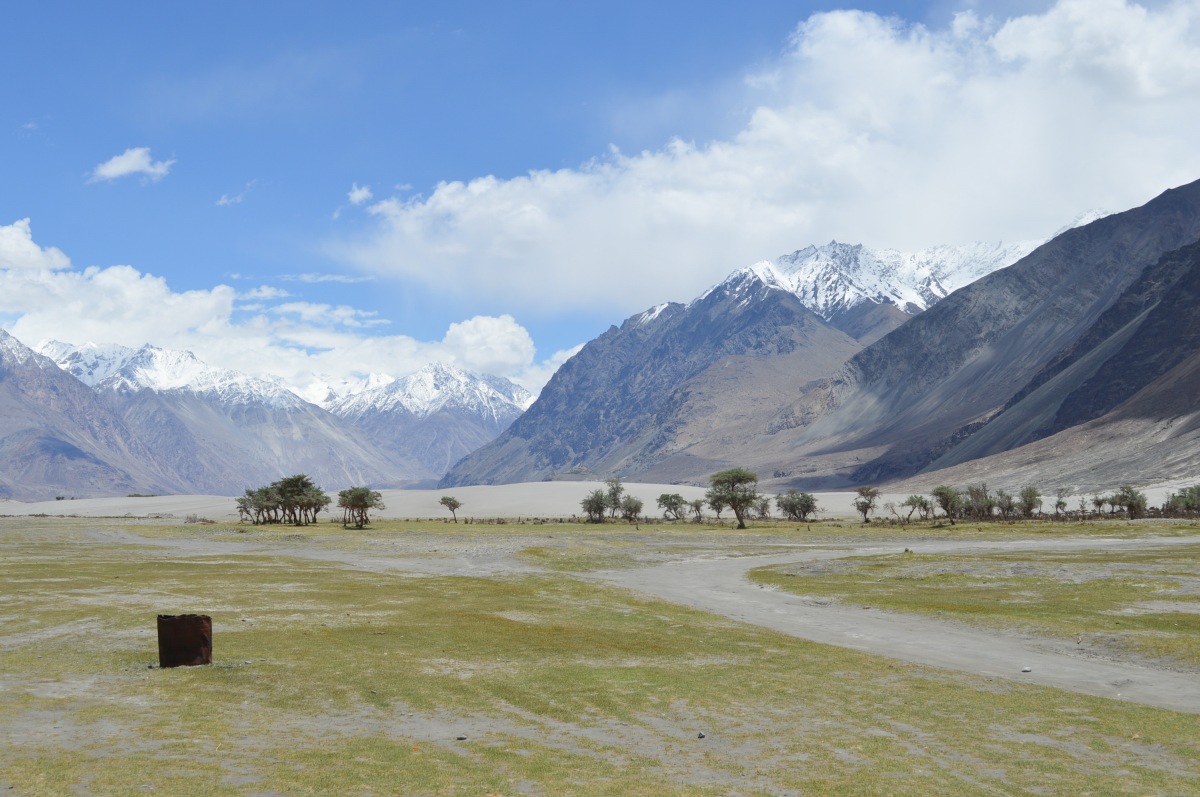
Around the confluence of Shyok River and Nubra River, lies this cold desert. The valley
holds a unique feature of being a desert in the Himalayas, as in there is this sand that one usually finds in a desert. A lot of special interesting geological activities occurred here, during the collision of the Indian and Eurasian tectonic plates, which led to the formation of Nubra Valley as a desert. Though not a pretty good photograph to depict the desert, it does portray the three different land forms which makes the place so unique – snow-capped mountains, some fertile soil and the pure barren sand. A very intriguing scene to witness, to ponder over how these elements of nature actually did come together to produce this one spectacle. It is spectacles like these, which ignite our curiosity and urge us to learn more about the many mystical phenomena of nature. We also have the two humped, furry Bactrian Camels, native to the place, in case you couldn’t believe it to be a desert. One of the most picturesque places on Earth!
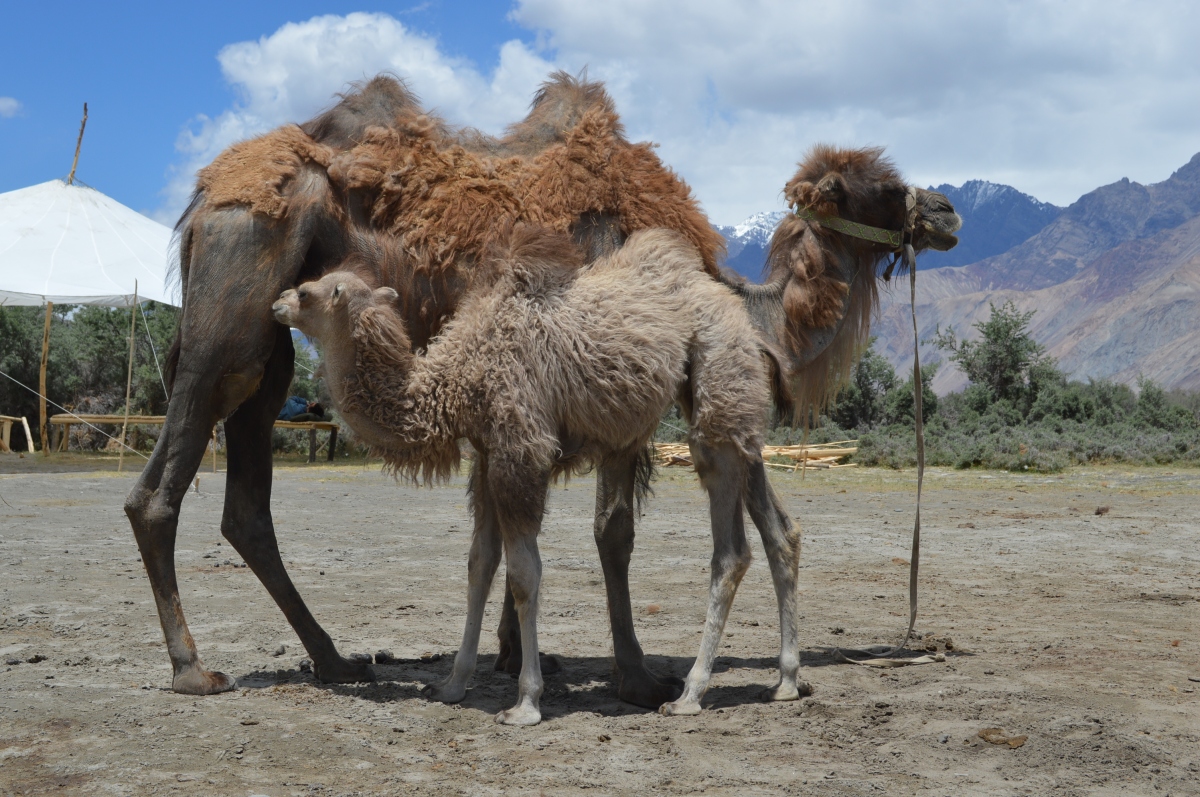

‘Gompa’ among many usages, is also used for a monastery. This greater than life statue of Maitreya Buddha adds to the serenity of the place. Maitreya Buddha, according to the scriptures, is the successor of Gautam Buddha and will intervene when dharma will be forgotten on Earth (its high time now I guess). The statue when viewed with the mountains as the backdrop stands out owing to its fresh colours, just like the cherry on a vanilla cake. What is so special about the Buddha statues is the way they reflect your own calmer self on to yourself, something which we seem to have lost these days. The way in which the hand of Buddha positions itself resembles the grace of a swan. The face and the eyes speak so much of compassion and motherly care, the mountains surrounding it start looking like his own children. The statue is around 106 feet tall and overviews the Shyok river valley like a silent guardian. Pure grace and beauty, beauty which would put even the make up clad miss worlds to shame. If the weather allowed me, I would have sat there all day looking at the statue, there certainly is no calmer sight than it…

‘Tso’ stands for a lake. This one is a real gem! A mirror for the skies, so perfect, that if there were no mountains, there would be no horizon visible, the lake and sky would merge seamlessly. Once again, we were lucky to have clear skies on that particular day, the result, the lake would put sapphire crystal to shame! It is also known to compete with emeralds on certain days. That’s how it looks from far away, from up close, the water is as transparent as a crystal. There is no more pleasing sight than that of your feet submerged in water with the little flickering shadows of the waves on water, playing on your feet. The tickling feeling of the water, the flat round stones to stand upon, and the cool breeze present a beautiful calming treat for the body. The water is slightly salty, which kind of makes sense as the place used to be a sea body long long time ago and the place itself is a kind of a sink, so water doesn’t flow out of it.
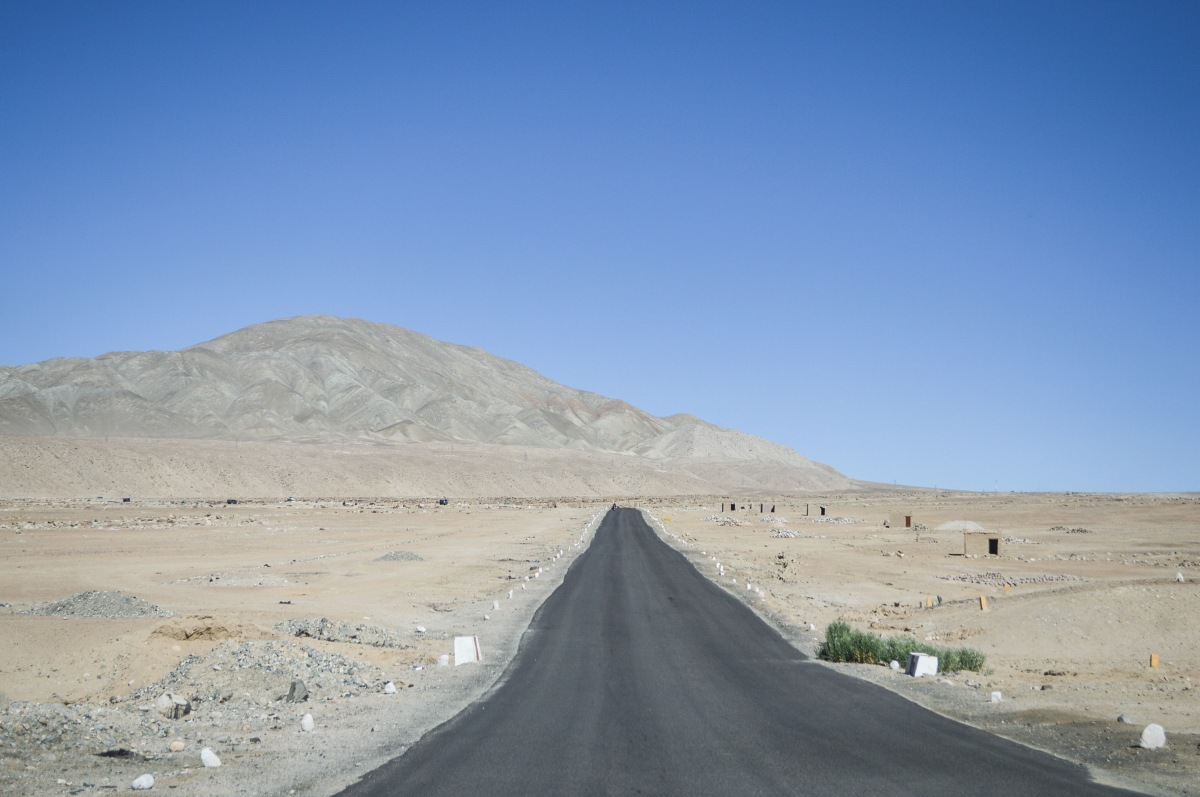
Not exactly NH1, this is NH1-D. But this highway deserves to be NH1-A, for two reasons: it connects Leh to Srinagar – two very important cities of the north most state in India, and most importantly, exposes you to a whole new plethora of landscapes by taking you from Ladakh to Kashmir. You name it, NH1-D has it – stark plains, steep ghats, river valleys, river crossings, rugged mountains, lush green hills, don’t expect a sea and it is no less than a roller coaster ride. It will mesmerize you with its dual tone – black and beige imagery, ridicule you with the magnanimous mountains, thrill you with the steepest and narrowest and craziest ghat turns, amaze you with the gushing cerulean blue rivers and enchant you with the palette of greens. It also happens to be one of the riskiest roads to travel on with boulders falling from the top of the mountains on the roads. And last but not least, it will fill you with awe for the Border Roads Organization who build roads through places where ordinary people can only dream of being. Watch out for the mystical Gurudwara Pathar Sahab Singh, Magnetic Hill, Zanskar and Sindhu river confluence, Alshi Chokso Temple, Lamayuru – Moonland, Zoji La and if you are the driver, the boulders too, some amazing natural phenomena all through the road! NH1-D will make you fall in love with traveling by road.

This place is enroute NH1-D, but needs to be given special mention, for all that this place is. This, is The Kargil War Memorial, a proud testimony to Operation Vijay – India’s most enthralling conquest of Pakistani intrusions. Located on the foothills of Tololing Hill, sector Drass, this memorial narrates to the world the courage of the Indian Military. All I can say is that a tribute is too small a feeling to convey to these martyrs…


The first major tourist spot in Kashmir going from Leh to Srinagar, Sonamarg is a small, tranquil, remote town in the Sindhu river valley. Literally, it means ‘meadow of gold’, but it got that name owing to a myth. More suitably, I would call it a ‘riot of greens’, for Sonamarg presents to you exactly that. Owing to all the abundant greenery here, horses, Pashmina sheep, goats and cows can be found grazing and roaming around all day long. The animals and humans coexist peacefully and in fact exhibit perfect symbiosis. Concrete has not yet made its way into this town to a great extent, so any architecture here is predominantly wooden made and this gives the place those pleasing sights of brown cottages in the midst of bright green pastures with the backdrop of tall snow capped mountains, and not to mention, the sparkling blue Sindhu river…
Acknowledgements
My heartfelt gratitude
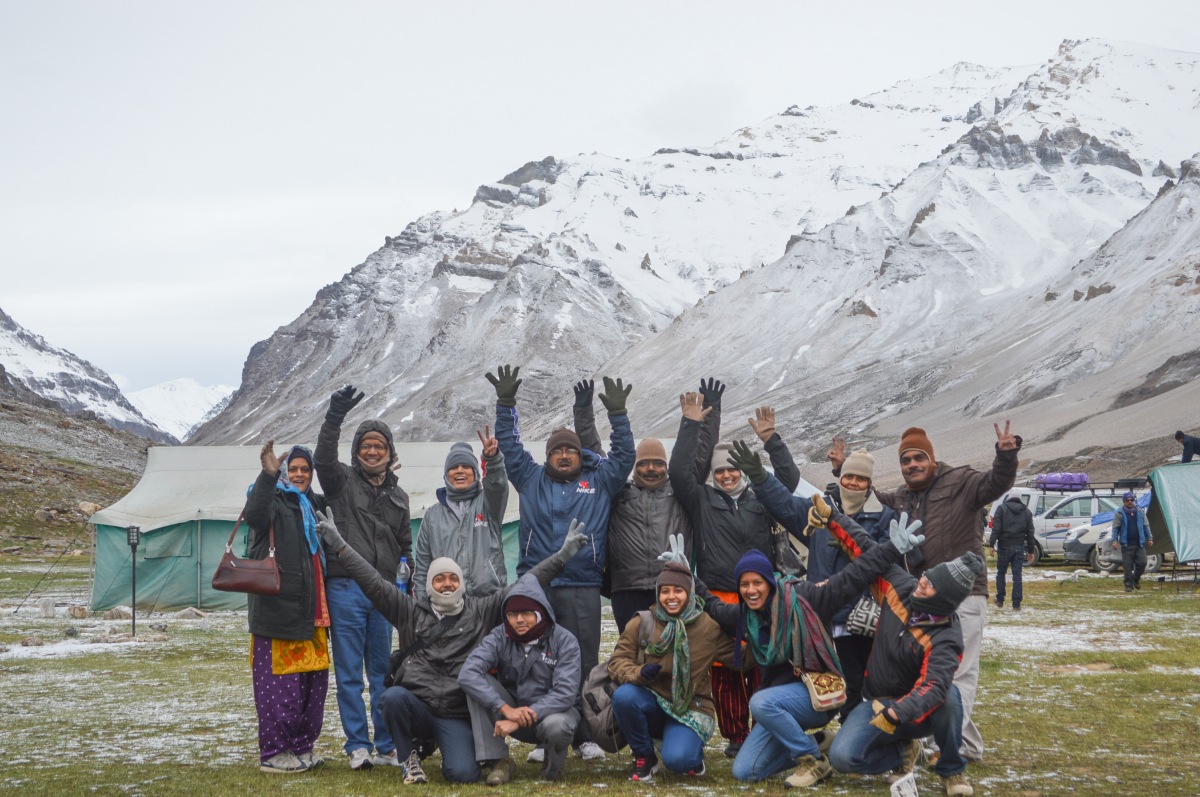
To Patil family, Salunkhe family, Kulkarni family and my family for coming up with the plan to undertake such an adventurous tour and making it more worthwhile with their awesome company. They also tolerated and excused my recluse for I was busy photographing the place and interacted quite less with them, something I regret.
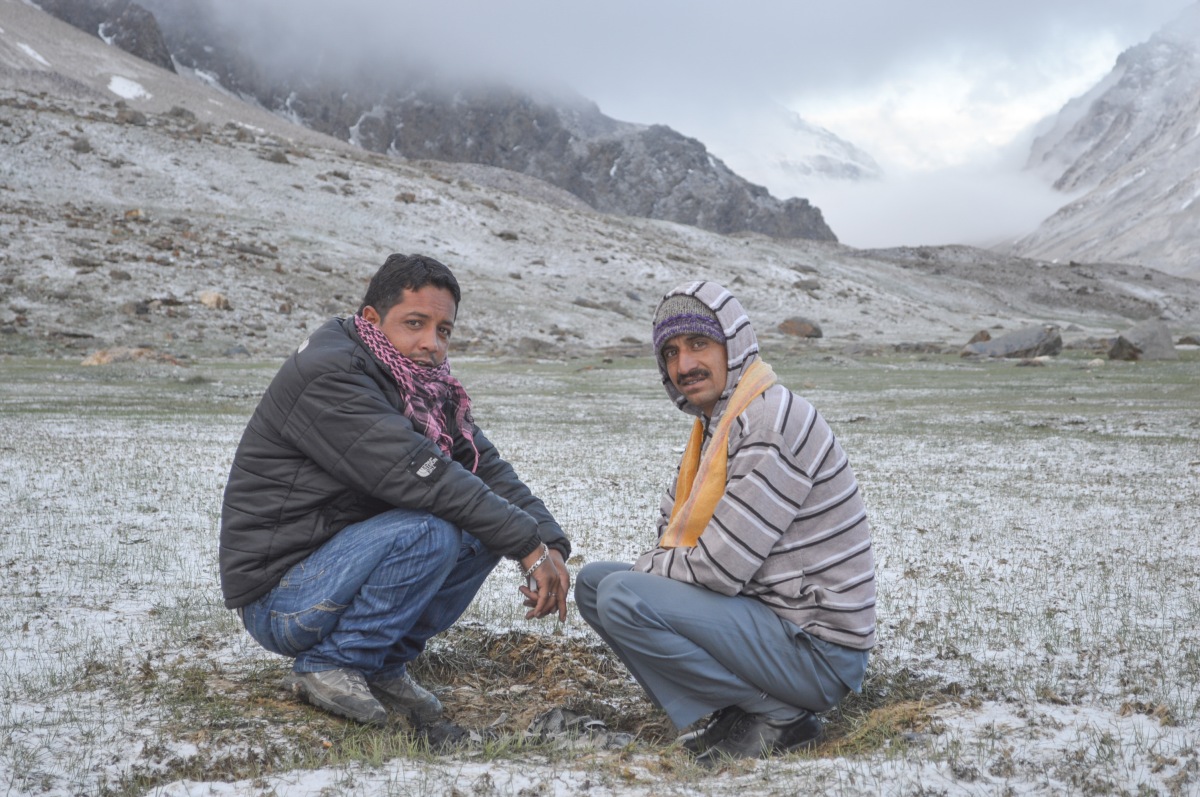
To our tour organisers – Himalayan Saga (the inspiration for naming the article), Overland Escape and Hill Tours, and their drivers. They took great care of us, showed us what we had come to see, handled the unseen situations very well, narrated to us the myths of all the places we went through and gave us additional excitement by their driving skills through the threatening roads of the Himalayan region.

To the Border Roads Organisation, Project Himank and these super humans who
brave such harsh weather conditions to facilitate smooth transport not just for the military but for civilians too. And when I say ‘harsh’, I am being lenient with my choice of words… Imagine digging up the snow first of all to find the road before you can repair or build it!
PS: All the acknowledgment images are after the overnight snowfall at Sarchu and photograph number 2,3 and 4 are a part of the Lahaul Spiti region (Himachal Pradesh)
PS: All the photographs except that of Maitreya Buddha and Kargil War Memorial were clicked by me, the Maitreya Buddha and Kargil War Memorial photographs are my father’s
Photographs and words will always prove to be insignificant and inadequate to convey, let
alone capture, the aura of this place. There is no other alternative than to behold it with your own eyes. Ideal time to visit, April to July – a bit obvious for it is summer season in the subcontinent, or if you are up to the challenge, try November to March, the winter season! Just go, witness the Great Grand Himalayas!
